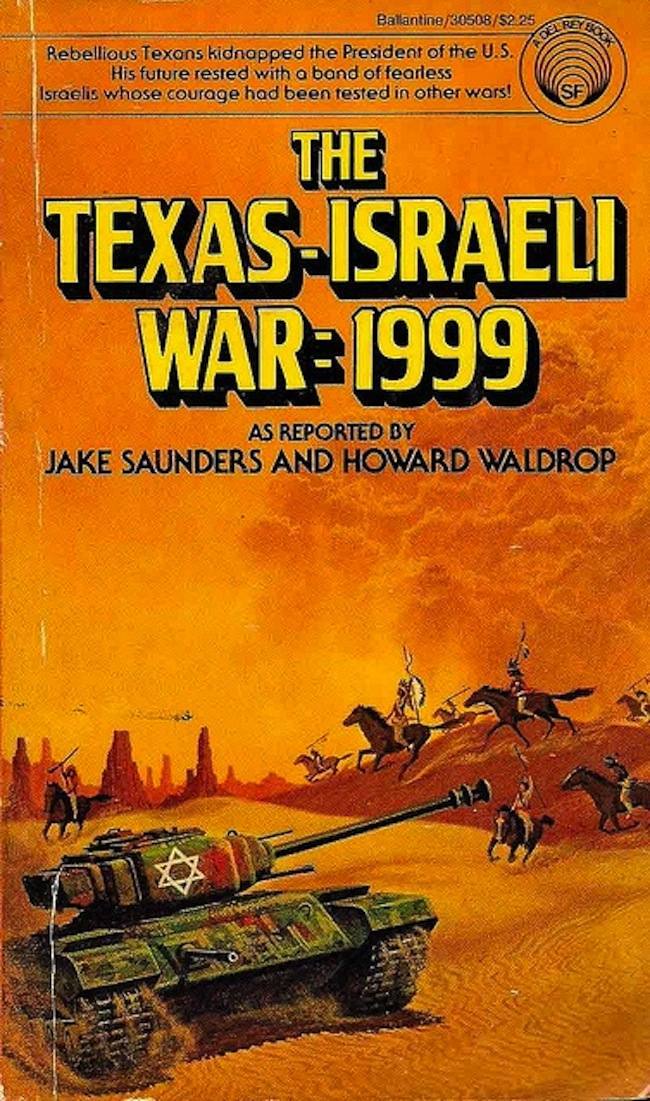The TEXAS-ISRAELI WAR 1999: Charlie Bagle, over
IN 1999, those rebellious Texans kidnap the President of the US of A. Only a bunch of fearless Israelis can save him. Jake Saunders and Howard Waldrop report on the TEXAS-ISRAELI WAR 1999.
The report was made in 1974, which appears odd (but it’s how newspaper reporting works).
On August 12, 1992, England’s tiny nuclear arsenal fell on Ireland, on South Africa, and finally on China. Instantly the planet went up in flames. In the first half year of what was to be called the War of ’92, half the Earth’s population perished. The United States was reduced to a vast underpeopled land — and, to make matters worse, Texas had seceded and taken her precious oil reserves. But Israel, virtually untouched in a world ravaged by war, was painfully overpopulated.
A review:
This is one of those books that is funny even when you are not sure the authors mean to be humorous. Inglestein’s Israeli mercenary unit has the radio call sign “Charlie Bagel,” and dances the “Hora” and sings the “Hatikvah” after battles. – Foreign Policy.com
It’s steeped in meaning, really:
“Finally, a smart and impartial history of a much overlooked episode in U.S.-Israeli relations. Set during the dying days of the Clinton Administration, when the now all but forgotten limited nuclear exchange killed nine out of every ten people in the world, not to mention a couple of goats. The two factions – a Chinese-Irish-Afrikaaner coalition versus a group of disgruntled Russo-British Cub Scouts – eventually ally with the United States while Europe waffles and is destroyed in the ensuing whipped cream and maple syrup. As neutrals, Israel managed to avoid all but the lingering lingerie and stands as one of the last bastions of Alan King jokes.
Meanwhile, Texas declares independence and a second US civil war develops, with a Lone Star Republic arising driven by oil interests and manned by a white supremacy Gestapo-like group headed by a coked-up George Bush, later to be reborn as The Tea Party.
The story very much reminds me of the movie Ishtar, especially the car-chase scene and the bag of groceries with the baguette sticking out of it. – The New York Review of Books
They wrote the story soon after the 1973 Yom Kippur War, in which Israeli forces efficiently defeated their Arab enemies and put to rest any residual notions of Jewish ineffectuality and victimhood. Saunders and Waldrop capitalized on this emerging Jewish imagery, inventing a story that emphasized the toughness and proficiency newly ascribed to Israel.
Seeking a setting for their story, the authors chose Texas, a place that shared with Israel many of the same mythic qualities of grit and determination. Texas, too, had achieved its independence against long odds. Texans, too, were famously protective of their autonomy, tenacious in their defense of liberty, and ready to fight whenever necessary. – Bryan Edward Stone is is an associate professor of history at Del Mar College in Corpus Christi
Sounds brilliant.
Posted: 17th, April 2013 | In: Books 0 Comments | TrackBack | Permalink



